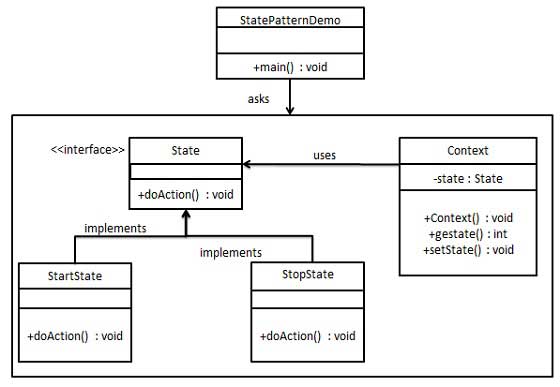In State pattern a class behavior changes based on its state. This type of design pattern comes under behavior pattern.
In State pattern, we create objects which represent various states and a context object whose behavior varies as its state object changes.
We are going to create a State interface defining an action and concrete state classes implementing the State interface. Context is a class which carries a State.
StatePatternDemo, our demo class, will use Context and state objects to demonstrate change in Context behavior based on type of state it is in.

Create an interface.
State.java
public interface State { public void doAction(Context context); }
Create concrete classes implementing the same interface.
StartState.java
public class StartState implements State { public void doAction(Context context) { System.out.println("Player is in start state"); context.setState(this); } public String toString(){ return "Start State"; } }
StopState.java
public class StopState implements State { public void doAction(Context context) { System.out.println("Player is in stop state"); context.setState(this); } public String toString(){ return "Stop State"; } }
Create Context Class.
Context.java
public class Context { private State state; public Context(){ state = null; } public void setState(State state){ this.state = state; } public State getState(){ return state; } }
Use the Context to see change in behaviour when State changes.
StatePatternDemo.java
public class StatePatternDemo { public static void main(String[] args) { Context context = new Context(); StartState startState = new StartState(); startState.doAction(context); System.out.println(context.getState().toString()); StopState stopState = new StopState(); stopState.doAction(context); System.out.println(context.getState().toString()); } }
Verify the output.
Player is in start state Start State Player is in stop state Stop State